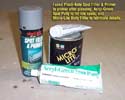
What's next?
Obviously I can't paint "41 Sniper" until after glassing her, so I'll begin this section on Painting the SBD with the steps I took to glass the plane. Then, I'll also include any ancillary scale details (exterior) in this section, such as panel lines, rivets, light fixtures, bombs, tailhooks, access hatches, etc.
Actually, the painting steps won't take place until after I've got pretty much everything done (except the interior). I would rather get all my bells and whistles built and mounted prior to painting, so that I can get better glue joints and can make any last minute surface modifications. I tried to get all interior mounting blocks taken care in the building section, so most details added now will be glued to the glassed surface without having to cut into the sheeting. Once the plane is completely detailed, painted, weathered and cleared, I will then move on to the cockpit/interior... that will be a nice little
winter project to finish things up with.
Determining a technique
I did a LOT of research on glassing techniques and materials only to find that this is an extremely controversial topic and there are a number of opinions out there on what works best. I weighed the bad and the good, considered my goals, and then decided to do some tests to determine what I felt was my best option. I have put together the results of my test here as a "Misc Data" article. Here's a link to the article...
Materials used for glassing
Here are most of the materials I used to glass my SBD and prepare the surface for painting...
In my next update I will cover all my steps for glassing the wing and fuse...




